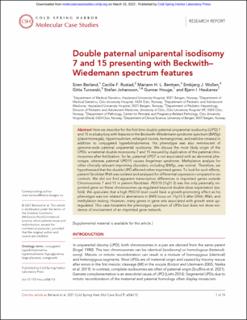| dc.contributor.author | Berland, Siren | |
| dc.contributor.author | Rustad, Cecilie | |
| dc.contributor.author | Bentsen, Mariann | |
| dc.contributor.author | Wollen, Embjørg Julianne | |
| dc.contributor.author | Turowski, Gitta Erika | |
| dc.contributor.author | Johansson, Stefan | |
| dc.contributor.author | Houge, Gunnar Douzgos | |
| dc.contributor.author | Haukanes, Bjørn Ivar | |
| dc.date.accessioned | 2022-04-21T08:29:01Z | |
| dc.date.available | 2022-04-21T08:29:01Z | |
| dc.date.created | 2022-01-18T15:45:10Z | |
| dc.date.issued | 2021 | |
| dc.identifier.issn | 2373-2873 | |
| dc.identifier.uri | https://hdl.handle.net/11250/2991852 | |
| dc.description.abstract | Here we describe for the first time double paternal uniparental isodisomy (iUPD) 7 and 15 in a baby boy with features in the Beckwith–Wiedemann syndrome spectrum (BWSp) (placentomegaly, hyperinsulinism, enlarged viscera, hemangiomas, and earlobe creases) in addition to conjugated hyperbilirubinemia. His phenotype was also reminiscent of genome-wide paternal uniparental isodisomy. We discuss the most likely origin of the UPDs: a maternal double monosomy 7 and 15 rescued by duplication of the paternal chromosomes after fertilization. So far, paternal UPD7 is not associated with an abnormal phenotype, whereas paternal UPD15 causes Angelman syndrome. Methylation analysis for other clinically relevant imprinting disorders, including BWSp, was normal. Therefore, we hypothesized that the double UPD affected other imprinted genes. To look for such effects, patient fibroblast RNA was isolated and analyzed for differential expression compared to six controls. We did not find apparent transcription differences in imprinted genes outside Chromosomes 7 and 15 in patient fibroblast. PEG10 (7q21.3) was the only paternally imprinted gene on these chromosomes up-regulated beyond double-dose expectation (sixfold). We speculate that a high PEG10 level could have a growth-promoting effect as his phenotype was not related to aberrations in BWS locus on 11p15.5 after DNA, RNA, and methylation testing. However, many genes in gene sets associated with growth were up-regulated. This case broadens the phenotypic spectrum of UPDs but does not show evidence of involvement of an imprinted gene network. | en_US |
| dc.language.iso | eng | en_US |
| dc.publisher | Cold Spring Harbor Laboratory Press | en_US |
| dc.relation.uri | http://molecularcasestudies.cshlp.org/content/7/6/a006113.full | |
| dc.rights | Navngivelse-Ikkekommersiell 4.0 Internasjonal | * |
| dc.rights.uri | http://creativecommons.org/licenses/by-nc/4.0/deed.no | * |
| dc.title | Double paternal uniparental isodisomy 7 and 15 presenting with Beckwith–Wiedemann spectrum features | en_US |
| dc.type | Journal article | en_US |
| dc.type | Peer reviewed | en_US |
| dc.description.version | publishedVersion | en_US |
| dc.rights.holder | Copyright 2021 The Author(s) | en_US |
| dc.source.articlenumber | a006113 | en_US |
| cristin.ispublished | true | |
| cristin.fulltext | original | |
| cristin.qualitycode | 1 | |
| dc.identifier.doi | 10.1101/mcs.a006113 | |
| dc.identifier.cristin | 1983883 | |
| dc.source.journal | Cold Spring Harbor Molecular Case Studies | en_US |
| dc.identifier.citation | Cold Spring Harbor Molecular Case Studies. 2021, 7, a006113. | en_US |
| dc.source.volume | 7 | en_US |
| dc.source.issue | 6 | en_US |

